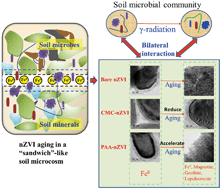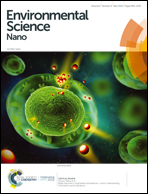Nano zero-valent iron aging interacts with the soil microbial community: a microcosm study†
Abstract
Nano zero-valent iron (nZVI) is a promising material for remediating metal(loid)-contaminated soils, but its aging in the soil ecosystem (unlike intensively studied aqueous systems) and interaction with soil microbial communities have not been resolved. In this study, three types of nZVI particles (bare nZVI, nZVI coated with carboxymethyl cellulose (CMC), or polyacrylic acid (PAA)) were incubated in soils with different microbial community compositions (realized by γ-radiation), and their aging was investigated using complementary microspectroscopic analyses. In addition, the soil microbial community in association with nZVI aging was assessed by employing DNA sequencing by using Illumina MiSeq. The results revealed a drastic morphological change of nZVI, which was transformed mainly into magnetite with a rough morphology. CMC coating decreased nZVI aging, whereas PAA coating accelerated it and facilitated magnetite, goethite and lepidocrocite formation. The γ-radiation induced soil microbial community change possibly slowed down nZVI oxidation (especially for bare nZVI). Iron-reducing/oxidizing bacteria (Bacillus, Shewanella, and Sediminibacterium) and fungal strains with a capacity for siderophore production may participate in nZVI aging. In return, nZVI presence and aging altered soil microbial communities. This study revealed the transformation of nZVI particles into Fe (oxy)hydroxides during aging in the soil ecosystem and their bilateral interactions with the soil microbial community, thus contributing to the assessment of nZVI use in soil remediation.



 Please wait while we load your content...
Please wait while we load your content...